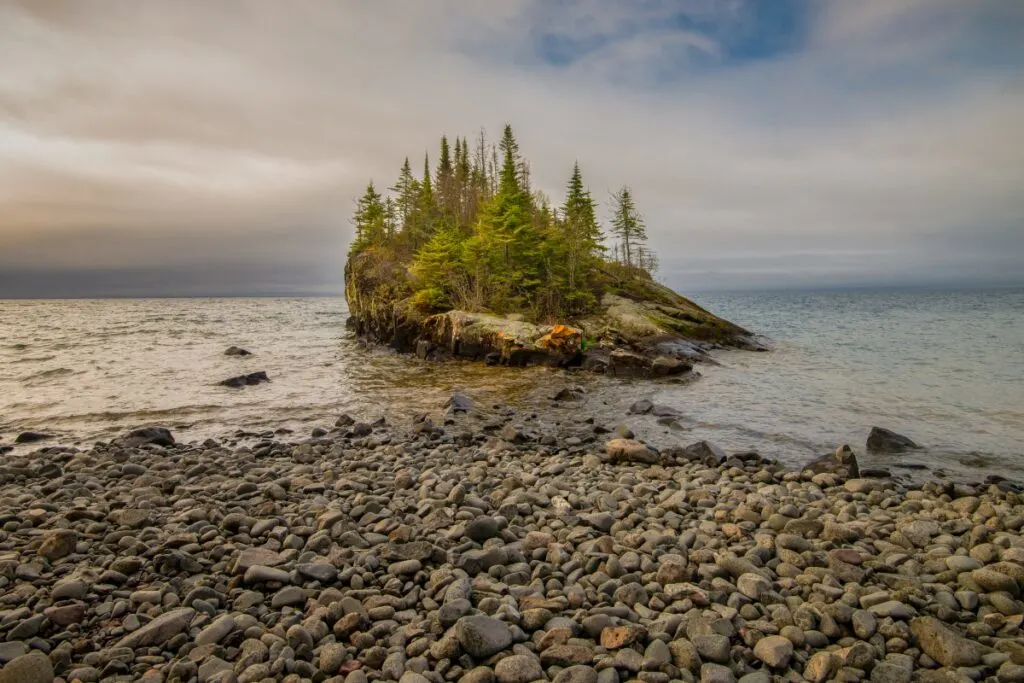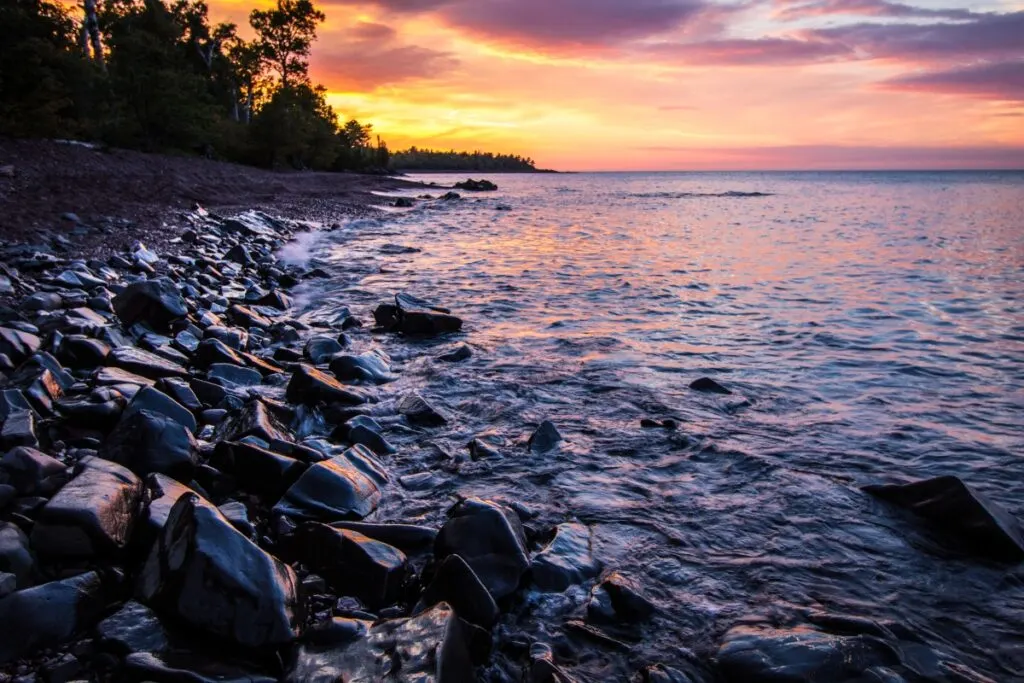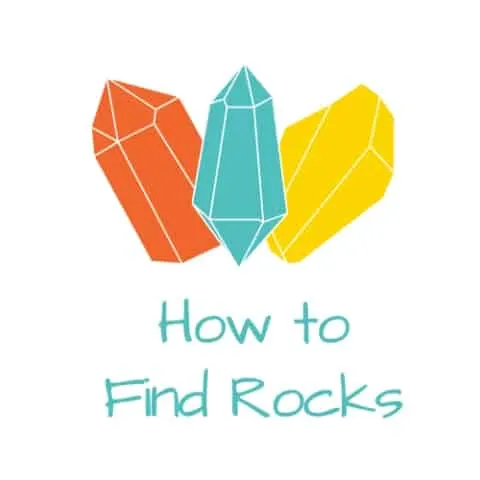As an Amazon Associate, I earn from qualifying purchases with no additional costs for you.
Lake Superior is among the most famous freshwater lakes in the United States, and Minnesota, Michigan, and Wisconsin border it. There are plenty of interesting rocks, minerals, and gemstones that you can find here.
Lake Superior has dozens and dozens of beaches stretched out in the states of Minnesota, Michigan, and Wisconsin, with some of the most notable being Paradise Beach, Rock Beach, Lake Superior Beach, Agate Bay Beach, Agate Beach Park, Sand Point Beach, Barkers Island Beach, and Meyers Beach, among others.
The most famous rock that many collectors wish to find on Lake Superior is the Lake Superior Agates. The good news is that this unique type of agate can be found on many beaches, whether you are in Minnesota, Michigan, or Wisconsin.
Let’s see exactly what you should know about rockhounding on Lake Superior beaches, some of the best beaches to start your journey, and what rocks you can find!

If you want to check out the best rockhounding tools, you can find them by clicking here (Amazon link).
Is it Legal to Take Rocks from the Lake Superior Beaches?
As is the case with many rockhounding locations, some are public, some are private, and the most important thing to do before you head out to any location is to research the local laws and regulations.
Regarding rockhounding on Lake Superior beaches, you should know that different laws apply based on your state. In most instances, it is illegal to take rocks from National Shorelines.
In other cases, you can collect only a certain amount of rocks from state parks. When it comes to private lands, you should always ask for permission first.
Some beaches have signs that let collectors know how much they can collect or if they are allowed to. If you are unsure if an area allows rock collection, contact the local authorities that manage the area.
BTW: Do you want to know more about rock and mineral identification? The books listed below are the best ones you can find on the internet (Amazon links):
- Smithsonian Handbooks: Rocks & Minerals
- Gemstone & Crystal Properties (Quick Study Home)
- Ultimate Explorer Field Guide: Rocks and Minerals (National Geographic Kids)
Best Rockhounding Beaches on Lake Superior
Once you are sure that you can collect rocks from a location you visit near Lake Superior, it’s time to buckle up and get ready for a big adventure because there are several exciting specimens you can find near Lake Superior shorelines.
Some of the best beaches on Lake Superior for finding rocks include:
- Paradise Beach, Lake Superior Beach, Agate Bay Beach, Rock Beach in Minnesota, Agate Beach Park, Eagle Harbor Beach, Squaw Beach in Michigan, Barkers Island Beach, Schafer Beach, and Cornucopia Beach in Wisconsin, among others.
Apart from these beaches, the ones located at the Keweenaw Peninsula, Isle Royale, and Manitou Island in Michigan are also highly abundant in various specimens. Let’s look at some of these beaches in their respective states and see precisely what you can find!
TIP: Pebbles are stones that everyone can easily find; there are kilometers of pebbles on the beaches. Find out more about this type of common rock in the article below:
All About Pebble Rocks: What Type of Rock, Forming & More
Beaches in Minnesota
Minnesota is probably the best state to rockhound around Lake Superior, and here you have the highest chances of finding Lake Superior Agates, which is also the state’s official gemstone since 1969.
Some of the best beaches in Minnesota along Lake Superior’s shoreline include:
- Paradise Beach, Lake Superior Beach, Beaver Bay Wayside, Black Beach, Kelsey Beach, Agate Bay Beach, Rock Beach, Beaver Bay, Bristol Beach Park, Brighton Beach, 42nd Ave E. Park Beach, Gull Rock, and Park Point Beach.
At Beaver Bay, if you head to the east and west beaches and search the area gravels, you might find thomsonite and Lake Superior agates, or you can head to Kelsey Beach or Gull Rock and explore the area beach gravels. At Grand Marais, if you explore the beaches to the east and west, you might find lintonite and thomsonite.
No matter what beaches you visit in Minnesota, you will always find something worth taking, including syenite rocks, pudding stones, and more. When it comes to Lake Superior agate, you can identify it through its red colorings marked by its high iron contents.
TIP: Check out this article for a complete rockhounding guide in Minnesota.
Beaches in Michigan
Exploring Lake Superior beaches in Michigan is just as exciting as in Minnesota, but the difference is that you might find a greater versatility when it comes to specimens.
Some of the best beaches around Lake Superior in Michigan include:
- Agate Beach Park, Great Sand Bay, Eagle Harbor Beach, First Sand Beach, Squaw Beach, Picnic Rocks Beach, AuTrain Beach, Mather Beach, Sand Point Beach, Chapel Beach, Sabie Beach, Gull Point, McLain State Park, Keweenaw Point, Isle Royale, or Manitou Island.
Exploring the Keweenaw Peninsula in Michigan will reveal plenty of specimens to gather, not just rocks. For example, the beaches north of Ahmeek are filled with agates, chalcedony, chert, jasper, or thomsonite.
The local beach gravels at Keweenaw Point reveal Keweenaw agates, but they are also present at Gull Point, and you will also find adularia, regular agates, jasper, chert, and thomsonite.
You can also find Petoskey stones at the Torch Lake beach gravels. Exploring the McClain State Park beaches is also rewarding.
Regarding the beaches surrounding Isle Royale and Manitou Island, you can find agates, carnelian, quartz, agate nodules, Isle Royale Greenstones, and Lake Superior agates. Focus on Carnelian Beach, Siskiwit Bay beaches, and the surrounding Manitou.
TIP: Check out this article for a complete rockhounding guide in Michigan.
Beaches in Wisconsin
Wisconsin has fewer beaches around Lake Superior than the other states, but that doesn’t mean you can’t find exciting specimens.
For example, some of the best beaches to search for rocks around Lake Superior in Wisconsin include:
- Barkers Island Beach, Schafer Beach, Cornucopia Beach, Meyers Beach, or the Halvor Reiten Park and Public Beach.
You can easily find jaspers and various agates, including Lake Superior agates, limestones, pudding stones, and more among the shoreline.
If you have trouble finding Lake Superior agates in Wisconsin, you should look for other areas, not just the beaches around Lake Superior, to find them.
If you decide to visit the beaches, always stay up to date with the local laws and regulations regarding collection, and if you end up on private lands, don’t collect anything unless you have permission from the landowners.
TIP: Check out this article for a complete rockhounding guide in Wisconsin.
What Are Rocks on Lake Superior Beaches?

There are various types of rocks, gemstones, and minerals that you can find on Lake Superior Beaches. In many instances, enthusiasts have even discovered amethyst, gold, silver, and even diamonds. However, let’s focus strictly on rocks for the moment.
Some of the most interesting rocks you can find on Lake Superior Beaches include:
- Various types of agates, such as Keweenaw agates or Lake Superior agates, jasper, basalt, ophitic basalt, porphyritic basalt, rhyolite, vesicular rhyolite, amygdaloidal rhyolite, granite, gabbro, diabase, slate, gneiss, and many others.
Probably the most famous rock you can find on Lake Superior beaches is the Lake Superior agate. This type of agate is often red-colored due to its high iron content, but it can also be orange or yellow.
White, grey, or black, and ten strips of colors can also be present on them. Among the most common type of agate is fortification agate, which has banding patterns.
These bands form patterns that look similar to the walls of a fort, but there is also a subtype, the parallel-banded agate, water-level agate, or onyx-fortification agate.
The rare eye agates are among the rarest as they have perfectly round bands dotting them, but other rare agates exceed 20 cm in diameter.
TIP: The rock types on different beaches worldwide depend on a particular area’s geological and geomorphological history. Check out common rocks on beaches in the article below:
25 Most Common Rocks on the Beach: How & Where to Find Them?
When it comes to basalt rocks are among the most common types of rock you will find on Lake Superior beaches, and there are several types that you can uncover.
Ophitic basalt rocks have lighter colors and appear to be painted flower petals. Porphitic basalt rocks have blobs of crystals and are rectangular-shaped.
Rhyolite rocks are also a type of basalt, but they are sandy-colored. Its mineral contents also differ from basalt. Some variations of rhyolite rocks found on Lake Superior are the vesicular rhyolite rocks and the amygdaloidal rhyolite rocks.
Vesicular rhyolite rocks were once filled with gases that formed bubbles during their formation, and when the lava cooled down, the gases left marks on the surface of these rocks.
Amygdaloidal rhyolite rocks have holes filled with molten minerals, mostly quartz or calcite. These crystal spots are rounded and give these rocks a unique look.
In rarer instances, even geodes or yooperlites were found on Lake Superior beaches, but all sorts of sedimentary, igneous, and metamorphic rocks pop up from time to time. You can also expect to find mudstones, sandstones, or pudding stones.
BTW: If you are looking for the best UV light for rockhounding, find out my picks below (Amazon links):
- BEST OPTION: Convoy 8+ 365nm UV LED Flashlight with Patented Glass Filter
- BUDGET OPTION: Karrong Rechargeable 1200 Lumen 395nm UV Flashlight
- OPTION FOR INDOOR USAGE: Prime Upgraded Big Chip 396nm UV
Conclusion
The beaches around Lake Superior are among the best for beachcombing and rockhounding, regardless if you visit the Minnesota, Michigan, or Wisconsin Lake Superior beaches.
You will always have something to look forward to and find if you search long enough and see the locations mentioned above.
No matter what beaches you visit, always check up on the local laws and regulations regarding rock collection, as these rules constantly change.
In other instances, visit the beaches early when fewer people are around because you will have a higher chance of finding something cool.
TIP: Running water alone is usually not enough to clean beach rocks, although a lot of flaky crustiness can be broken off by hand. Find out more in the article below:
Cleaning Rocks From the Beach: 7 Ways How to Do It Properly
